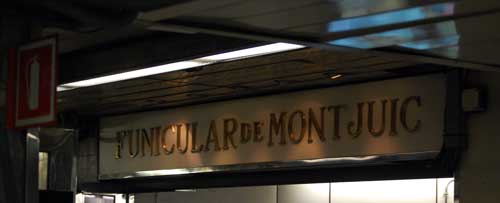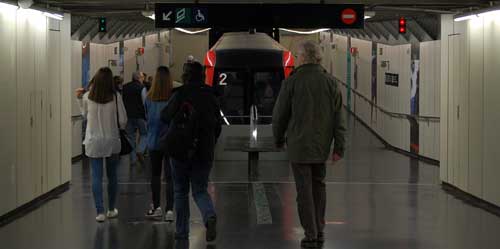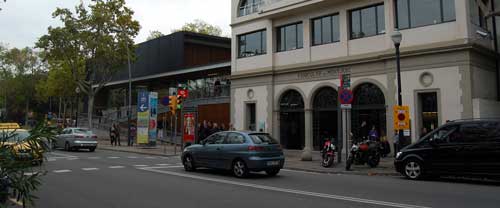As we know, public transit agencies rarely implement cable transit solutions within their networks (hence this website), and when they do, they tend to implement them not as fully-integrated components of their network but rather as isolated, independent components (here or here for example).
They’re treated kind of like that awkward, sticky-fingered step-cousin you only see at certain holidays—kept off to the side and left to fend for themselves.
That’s what makes the Monjuïc Funicular in Barcelona so wonderful. It isn’t an afterthought or at the kiddie’s table.
The system, originally built in 1928 to serve the hilltop Expo of 1929, was rebuilt by Leitner in 1992 so as to cope with the increased traffic to and from the hilltop due to the wildly successful Barcelona Summer Olympics.
While only a modest 758 meters long and ostensibly built solely for tourists, the system is fully-integrated into Barcelona’s wider transportation network and is operated by TMB, the city’s local transportation agency. There are no additional fares to ride the system and the station platform is a mere 30 second walk down the hall from the nearby Paral-lel metro station platform.
You could, if you wanted to, pay your metro fare at the top of the funicular and then transfer directly to the metro without going outside, paying an additional fare or even passing through a turnstile—it’s that wedded into the overall system.
Currently, the system operates at approximately ten minute headways with a trip time of only two minutes. But during the Olympics, the system was operating at full-tilt: 10 m/s speeds, with three minute headways and cabins packed to the brim with 400 passengers.
Do the math and you quickly realize that during the Olympics, the Montjuîc Funicular was moving 8,000 pphpd. For those who are keeping track, that’s thought to be the most number of people a funicular had ever carried in history and is a record that stands to this day.
Unfortunately, the headways between vehicles experienced back then are not experienced now.
The current wait times for the vehicles are not exactly prohibitive—after all, at ten minutes they’re still within the tolerance of most urban frequent service bus schedules—but they do feel excessively long for what is such a short ride. Certainly it is possible for the system to operate at shorter frequencies, but to do so would only increase the wear-and-tear on the system.
That’s one of those operational trade-offs that causes problems. From a rider’s perspective, a ten minute wait for a two minute journey hardly seems reasonable, but does it make sense for a transit agency to operate a system in an inefficient manner so as to provide for a greater level of customer satisfaction?
Hard to say.
Notwithstanding that one minor issue, the Montjuïc Funicular is exemplary in its overall function and integration. It’s not the typical cable car bastard child of the transit network; it’s part of the family. That’s what makes it valuable as a case study. The Montjuïc Funicular teaches you that if you treat a cable car system as transit, then it is transit. That’s the (easily remedied) mistake that London is making with their cable car line.
Perhaps most interesting?
Its upper terminus is right next to another urban cable transit line and what must certainly be one of the world’s most interesting urban gondola systems—but we’ll talk about that next week.





5 Comments
This is good to see – integration is something that mainland Europeans seem to master with ease but Britain struggles to grasp even the basics. The gondola in London is one example but it’s even more widespread than that. Where I live in the north of England, there are two mainline stations roughly equidistant from my town, both about an hour’s drive away. From these stations direct trains can be caught to London and many other major cities. To get to one mainline station a regional train would need to be taken and to get to the other, a bus would be needed. In both instances the train/bus will arrive/depart 5-10mins before/after the mainline train arrives/departs (negatively). With an hour between trains/buses this means a significant wait. It is a wonder that timetables can be produced in such a counter-intuitive manner, however this is the norm in Britain. The result is that people will almost always choose to get a lift to the station rather than wait the inevitable 50 minutes at the mainline station. This seems to me among the most basic principles of public transit integration… so why is this opportunity consistently missed?!
@ Ross: I’ve recently been in Switzerland and I think the transport agency coordinates the schedules in a manner so that you typically have enough time to catch the next train. Apparently due to the timeliness of Swiss trains, some passengers can actually leave as little as 5 minutes to catch the next train. Perhaps the problem in England is that the agency that operates the train/bus is different from the regional train.. but that’s purely a guess.
@ Steven: Sorry to hijack your post somewhat with this tangent!
@ PeterK: Yes, that is certainly true. Whereas the railways in Switzerland are largely nationalised, the railways in Britain are privatised and therefore different companies operate different railways. However, there is a government organisation that is supposed to bring cohesion to the whole process, evidently with varying degrees of success! While I do generally subscribe to the opinion that Switzerland is a shining beacon of hope when it comes to public transport, I was recently disappointed while visiting Switzerland with late trains and barely scraped connections. I recall Swiss transport being much closer to the ideal in the past, or perhaps I’m just being nostalgic!